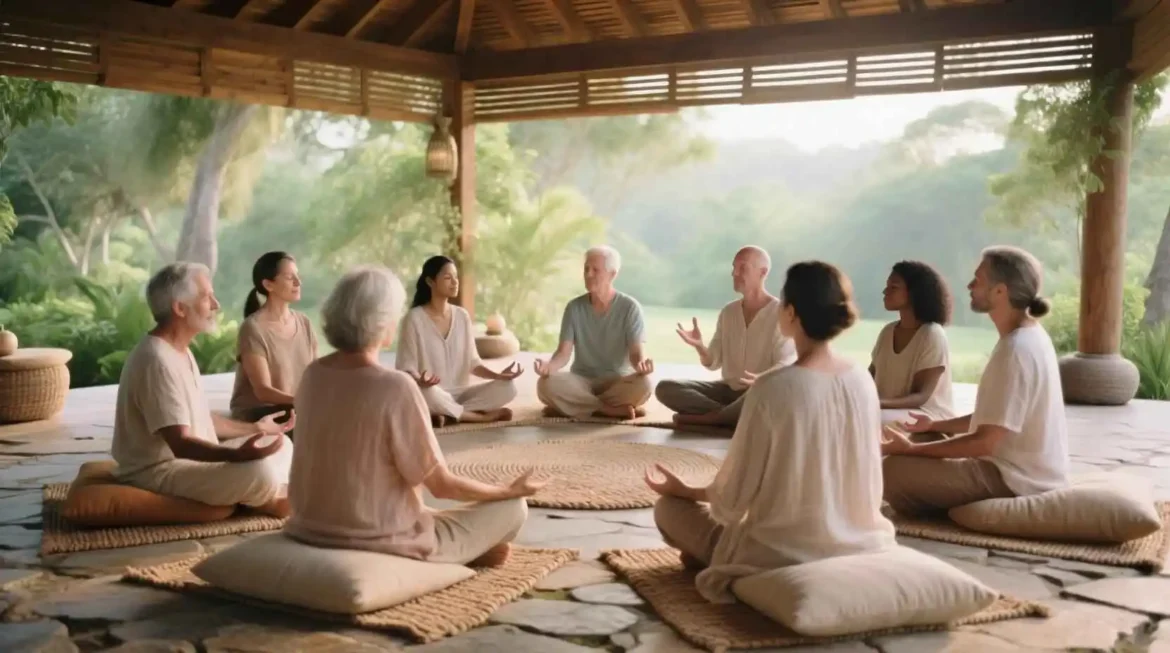- Thoroughly Research the Facilitators: The heart and soul of any retreat lie with its facilitators. Vetting them thoroughly is paramount. Delve into their professional background, looking for comprehensive training, relevant certifications (e.g., in tantra, somatic sex education, trauma-informed practices, psychology, or coaching), and years of experience. Beyond credentials, seek to understand their personal philosophy on pleasure, intimacy, consent, and embodiment. Do their core values resonate with your own? Are they committed to creating a safe, inclusive, and ethical space? A misalignment here could significantly impact your comfort and ability to fully engage.
- Actively Seek Out Testimonials and Reviews: Do not underestimate the power of social proof. Seek out and carefully review testimonials, independent reviews, and feedback from previous participants. Look beyond generic praise; pay attention to specific details about the retreat’s atmosphere, the facilitators’ approach, the effectiveness of the practices, and the overall participant experience. Are there consistent themes? Do the reviews reflect a sense of safety, professionalism, and genuine transformation? Reliable reviews often offer invaluable insights that marketing materials might not.
- Gain a Clear Understanding of the Curriculum: Request a detailed itinerary or curriculum outline well in advance. Understand the specific methodologies and practices that will be employed – whether it’s breathwork, tantric practices, somatic exercises, conscious movement, communication workshops, or other modalities. Crucially, assess if these practices align with your personal comfort level, your readiness to explore, and your specific goals for attending the retreat. Don’t hesitate to ask for clarification if anything is unclear; transparency from the retreat organizer is a positive sign and ensures there are no uncomfortable surprises.
- Inquire About Group Dynamics and Nudity Policy: Given the intimate nature of these retreats, gaining clarity on group dynamics and the policy regarding physical touch and nudity is absolutely essential. Understand the retreat’s philosophy on consent, boundaries, and interpersonal interactions. Is physical touch encouraged, optional, or prohibited outside of specific exercises? If nudity is part of the experience, is it mandatory, optional, or integrated only within specific, clearly defined practices? Absolute transparency on these matters allows you to make an informed decision that respects your personal boundaries and comfort zones. Your safety and comfort are paramount.
- Carefully Consider the Environment and Location: The physical environment of the retreat can significantly impact your sense of relaxation, safety, and openness. Consider the location – is it serene, private, and conducive to introspection and deep work? Evaluate the facilities (accommodation, practice spaces, food) for cleanliness, comfort, and their ability to support the retreat’s objectives. A harmonious and supportive environment can amplify the positive effects of the experience, allowing you to fully immerse yourself without external distractions or discomfort.
- Clarify the Financial Investment and Inclusions: Ensure you have a complete and transparent understanding of the financial investment. This includes not just the headline cost, but also what precisely is included (e.g., accommodation, meals, all workshops, supplementary materials, pre/post-retreat support) and what is not (e.g., travel, personal expenses, extra sessions). Inquire about payment plans, deposit requirements, and, importantly, the refund and cancellation policy. Clear financial terms prevent unwelcome surprises and allow for proper budgeting.
- Ultimately, Trust Your Intuition: After gathering all the necessary information, take a moment to pause and listen to your inner wisdom. Does the retreat, its facilitators, and its approach genuinely feel right for you? Does it evoke a sense of trust, excitement, and safety? Your intuition is a powerful guide, especially when embarking on such a personal journey. If something feels off, even subtly, it’s worth exploring further or considering other options. Ultimately, the right retreat will be one where you feel fully supported, respected, and empowered to explore your sensuality in a safe and meaningful way.
Our Concluding Thoughts: Embracing Our Full Selves
Our exploration of orgasm retreats reveals them to be far more than just a fleeting experience; they are a profound invitation to reclaim and celebrate our inherent capacity for pleasure, connection, and deep self-knowledge. In a world that often compartmentalizes our bodies from our minds and spirits, these retreats offer a powerful antidote, fostering integration and wholeness.
We believe that by consciously engaging with our pleasure, we unlock vital life force energy, heal old wounds, and step more fully into our authentic power. It’s a brave and beautiful journey towards radical self-acceptance and a more vibrant way of living. For those who feel the call, a journey into the world of orgasm retreats can truly be a transformative step towards embodying a more joyful, connected, and fully expressed version of ourselves.
FAQs
General Questions About Orgasm Retreats
1. What is an orgasm retreat?
An orgasm retreat is a specialized workshop or getaway designed to help individuals or couples explore and enhance their sexual pleasure, intimacy, and orgasmic potential through guided exercises, tantric practices, and psychological techniques.
2. Who can attend an orgasm retreat?
They are open to individuals of all genders, sexual orientations, and relationship statuses. Some retreats cater to couples, while others focus on solo empowerment.
3. Where are orgasm retreats held?
They can be hosted at wellness retreat centers, luxury resorts, or private venues in locations like Bali, Costa Rica, Spain, or the U.S.
4. What activities are included?
Sessions may involve guided meditation, tantric exercises, breathwork, sensate focus, erotic dance, consent workshops, and anatomy education.
Effectiveness of Orgasm Retreats
5. How effective are orgasm retreats in enhancing pleasure?
Many participants report breakthroughs in body awareness, stronger orgasms, improved intimacy, and reduced sexual shame. Effectiveness depends on openness and follow-up practice.
6. Can orgasm retreats help with anorgasmia (difficulty climaxing)?
Yes—retreats often teach techniques to overcome mental blocks, improve arousal, and explore new pathways to orgasm.
7. Do these retreats help with relationship issues?
Couples often experience deeper emotional connections and better communication, but results vary based on commitment to practice.
8. Are the benefits long-lasting?
Long-term benefits depend on integrating learned techniques into daily life. Some retreats offer post-retreat support (e.g., online communities or coaching).
9. Are there scientific studies supporting their effectiveness?
While research on retreats specifically is limited, studies on tantra, mindfulness, and sensate focus show positive impacts on sexual satisfaction.
10. Can introverts benefit from orgasm retreats?
Yes—many exercises are solo or partner-based in a safe, non-judgmental environment. Some retreats offer private sessions.
Factors to Consider Before Attending
11. How do I choose the right retreat?
Consider:
- Facilitator credentials (look for sex therapists, tantra coaches).
- Group size (smaller groups offer more personalized attention).
- Focus (e.g., solo pleasure vs. couples’ intimacy).
12. What should I expect regarding nudity or touch?
Policies vary. Some retreats encourage non-sexual nudity or consensual touch; others are strictly non-contact. Always clarify boundaries beforehand.
13. Are orgasm retreats safe?
Reputable retreats prioritize consent, hygiene, and emotional safety. Avoid programs that pressure participants into unwanted activities.
14. How much do orgasm retreats cost?
Prices range from $500–$5,000+, depending on location, duration (weekend vs. week-long), and amenities.
15. What’s the typical duration?
Weekend workshops (2–3 days) or immersive retreats (5–7 days).
16. Should I attend alone or with a partner?
Either is fine. Solo attendees focus on self-discovery; couples deepen their connection.
17. Is prior experience required?
No—most retreats welcome beginners but may offer advanced-level programs.
18. What’s the age range of participants?
Most cater to adults (25–60+), but some are designed for specific age groups (e.g., post-menopausal women).
19. Are LGBTQ+ individuals welcome?
Many retreats are inclusive, but check facilitator language and policies.
20. What if I feel uncomfortable during sessions?
Reputable facilitators encourage checking in with yourself and honoring your limits. You can opt out of any activity.
Logistics & Preparation
21. What should I pack?
Comfortable clothing, a journal, water bottle, and any personal items (e.g., massage oil). Some provide lists.
22. Are meals included?
Most retreats offer healthy meals (specify dietary needs in advance).
23. Will there be alcohol or drugs?
Typically no—substances can interfere with mindfulness and consent.
24. How do I prepare mentally?
Reflect on intentions (e.g., “I want to release shame around pleasure”) and research the retreat’s philosophy.
25. Is there aftercare support?
Quality retreats offer integration resources (e.g., follow-up calls, online groups).
Myths & Misconceptions
26. Are orgasm retreats just about sex?
No—they focus on holistic pleasure, self-awareness, and emotional well-being, not just physical acts.
27. Do I have to orgasm to benefit?
No. The goal is exploration, not performance.
28. Are these retreats only for women?
No—programs exist for all genders, including male-centric or non-binary-focused retreats.
29. Will strangers touch me?
Only with explicit consent. Most exercises are solo or with a partner.
30. Are orgasm retreats a replacement for therapy?
They can complement therapy but aren’t substitutes for treating trauma or medical conditions.
Final Thought
Orgasm retreats can be transformative for those open to exploring pleasure mindfully. Research thoroughly, communicate boundaries, and choose facilitators aligned with your goals.
Medical Disclaimer:
The information provided on this website is for general educational and informational purposes only and is not intended as a substitute for professional medical advice, diagnosis, or treatment. Always seek the advice of your physician or other qualified health provider with any questions you may have regarding a medical condition. Never disregard professional medical advice or delay in seeking it because of something you have read on this website.



